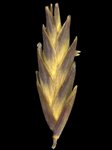
T. plurinervata spikelet.
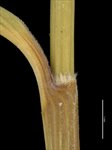
T. plurinervata orifice and sheath.
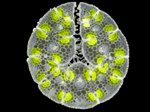
T. plurinervata leaf section.
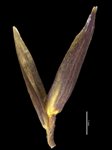
T. plurinervata glumes.
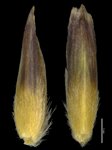
T. plurinervata lemmas.

T. plurinervata paleas.

T. plurinervata map.
Name
Triodia plurinervata N.T.BurbCitation
Austral. J. Bot. 8: 390–391 (1960)
Derivation
plurinervata — from Latin plur-, many, and nervus, nerves, in reference to the many-nerved (≥5) glumes.Common name
West Coast Spinifex
Synonyms
None
Diagnostic features
Foliage non-resinous; leaf sheath surfaces glabrous or with shortly hairy margins; orifice minutely hairy with hairs <0.2 mm long; inflorescences unbranched; pedicels 0–2 mm long; leaf blades non-resinous, amphistomatous (hard-type); lower glume elliptic, 5–8-nerved; lemmas entire or shortly lobed, uniformly textured (indurated for most of their length and scarcely differentiated from lobes), not awned; lowest lemma midlobe 0–0.5 mm long; distribution in subcoastal sand plains of the Carnarvon bioregion and further south.
Habitat
Occurs on subcoastal sand plains.
Distribution and frequency
Endemic to subcoastal Western Australia. Only in the extreme south-western portion of the area considered here, extending south along the coast.
Similar species
Triodia plurinervata is a member of the Basedowii group, sharing the group features of non-resinous foliage, amphistomatous (hard-type) leaf blades and many-nerved (≥6) glumes.
It is distinguished from all other Basedowii group species except T. infesta and T. mallota by having an unbranched inflorescence (lacking side-branches and spikelets inserted directly on the main axis), and short pedicels 1–2 mm long (inflorescence either branched, or if unbranched then longest basal pedicels more than 3 mm long in other species).
Triodia mallota is distinguished by being densely woolly on sheath surfaces (glabrous or with shortly hairy margins in T. plurinervata), and occurs near Pannawonica in the Pilbara.
Triodia plurinervata is distinguished from T. infesta by having shorter spikelets (5–9.8 mm long) shorter glumes (3–4.2 mm long), and subcoastal distribution compared to T. infesta (spikelets 12.5–17 mm long; glumes 5.2–6.2 mm long and distribution in the interior).
Conservation status
Not considered at risk.
Identification without florets
Triodia infesta is the only species in the Carnarvon bioregion that has an unbranched inflorescence.
Variation
A uniform species.
Notes
The concept of T. plurinervata in Lazarides (1997), Lazarides et al. (2005) and Ausgrass (Sharp & Simon, 2002; Simon & Alonso, 2014) included the inland forms now named as T. infesta.
A full description of T. plurinervata can be found in Anderson et al. (2017a).